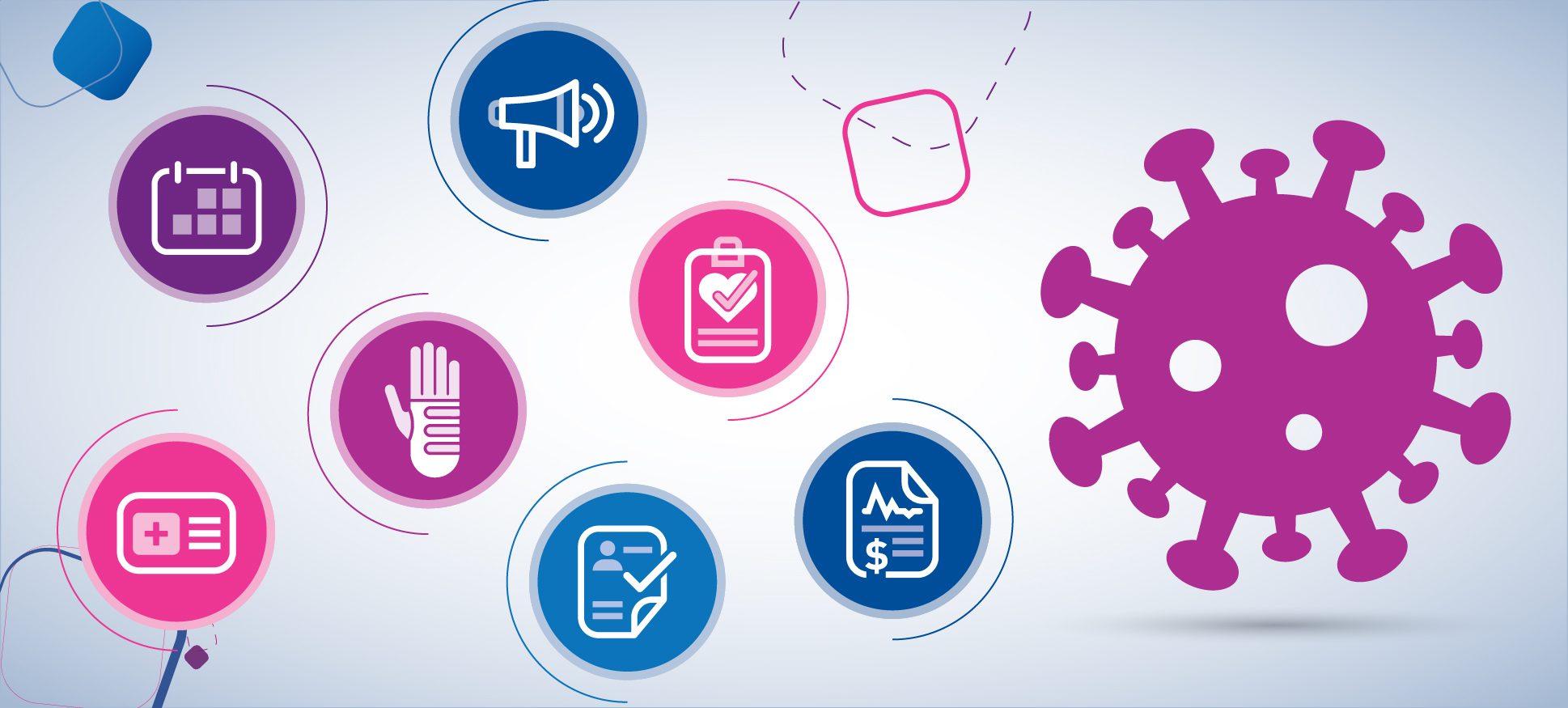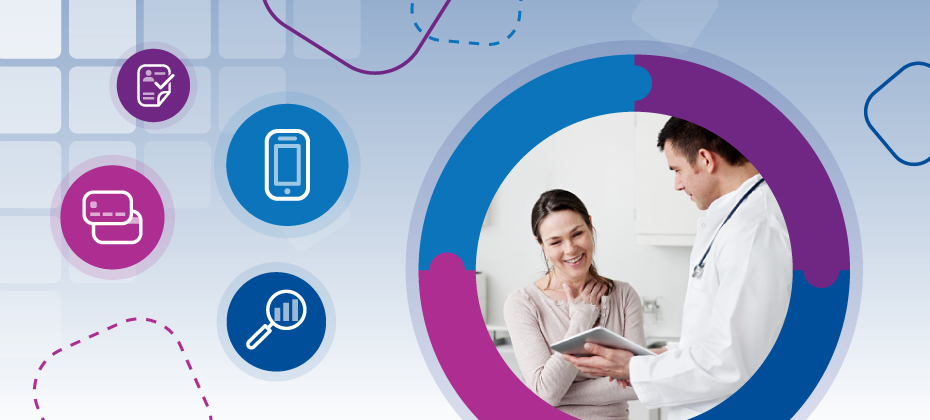Patient Access
Learn how to improve patient access by verifying critical patient information and collecting patient payments prior to service.

As payers and providers count down the days until the implementation of the No Surprises Act in January 2022, healthcare price transparency and billing remain trending topics in the healthcare world. The Act is the latest in a series of federal and state commitments to help healthcare consumers feel more prepared and informed about their medical costs. Consumers have come to expect a payment experience that matches the way they shop around for other household budget-eaters, such as cars and laptops. But healthcare isn’t like other purchases – it’s complex, high stakes, and often incredibly opaque. Lists of shoppable services are often difficult to navigate, information on quality can be hard to come by, and the reality is that patients don’t always have the power to choose how they access care. The CMS final rule on price transparency and the new regulations for balance billing signal a high-level desire to improve the healthcare experience with patient-friendly pricing. It seems to be working. Experian Health’s State of Patient Access 2.0 survey, fielded in June 2021, reveals that price transparency remains important to both patients and providers. It’s also improved substantially in the six months since the first survey. Back in November 2020, more than half of survey participants had final costs that differed significantly from their billing estimates. By June, this figure had dropped to just 14%, which means more patients are able to plan for their final bill with confidence. Given these improvements, what’s on the horizon for price transparency? In the latest of our expert interview series, Greg Young, Senior Director of Marketing, talked to Dan Wiens, Product Director for Patient Estimates at Experian Health, about the future of patient estimates and price transparency. Watch the interview below: What’s driving the change in patient perception when it comes to healthcare price transparency? According to Wiens, two major factors are improving patient attitudes to pricing estimates: “At the height of the pandemic, hospitals were seeing fewer patients and many elective procedures were canceled, so there weren’t a lot of estimates going out. Secondly, there has been a massive push for price transparency from governments and providers. In January 2021, federal regulations came out specifically to give patients a better view of their out-of-pocket expenses. Many more facilities are launching price transparency tools, as opposed to using databases that guess what a patient’s obligation will be.” As those regulatory requirements come into force, fewer patients are surprised by their final bill. By providing accurate estimates ahead of time, supporting patients to manage their financial journey, and providing personalized patient statements, hospitals are pushing forward with transparent pricing strategies that help patients feel in control of their medical bills. Is the problem of price transparency solved if patients, providers and politicians are in favor of these new regulations? Providers recognize the benefits of transparent pricing: 9 out of 10 providers told us they agree that providing accurate estimates helps patients to pay their bills. With everyone seemingly supportive of this approach, some might see the challenge as resolved. The problem then becomes a question of implementation. Wiens says the job isn’t quite finished yet: “Healthcare price transparency will continue to evolve and grow. Now that patients can see their out-of-pocket expenses for very specific procedures, they’ll want it for the rest. Hospitals are very quickly learning that when a patient knows what they owe, they can accommodate larger expenses and take care of smaller bills immediately. And the government is clear that they don’t want patients to be in the dark about what they owe, so we’ll see more and more transparency requirements.” Hospitals looking to step up their pricing estimates now have a variety of tools at their disposal. Offering patients personalized information in a convenient and easy-to-understand format should be top of the list. Patient Payment Estimates help patients understand their financial responsibility before even coming in for care. Patients get a cost breakdown straight to their mobile device and can immediately pay then and there if they want. This can also be integrated with Patient Financial Advisor, which provides real-time benefits information, and directs patients to appropriate payment plans and charity options. It makes the process less stressful and reduces the risk of uncompensated care for providers. Is there more healthcare price transparency regulation on the horizon? Regulations will continue to be a major driver of evolving healthcare pricing policy in the next few years. In addition to the federal government’s price transparency mandate in 2021 and the No Surprises Act, which takes effect in January of 2022, at least 22 states have followed suit in implementing price transparency and balance billing requirements. Wiens says, “price transparency and balance billing regulations will continue to evolve. A lot of hospitals want to make changes on their own, but some will need a little bit of extra motivation, which will come from regulations.” As focus shifts into more complex areas of healthcare finance, regulatory requirements will continue to ramp up. While the price transparency rule focused simply on helping patients understand their out-of-pocket expenses, the No Surprises Act is much more comprehensive and complex. This new regulation covers patient benefits, insurance claim processes, and determines whether patients are in or out of network. Further regulations are likely to dig deeper, to make sure patients understand what they’re paying. Providers that embrace a transparent approach to patient payments will be ahead of the game when those changes come into play. Download the State of Patient Access Survey 2.0, to find out more about the future of patient-friendly pricing.

COVID-19 transformed the patient journey, and it's clear when we evaluate every step. Data and technology gave patients the convenience, flexibility, and control to get care on their terms, and these changes will be here to stay. From marketing to scheduling to payments and more - providers and payers have ample opportunities to respond to these changes and will need to adapt their future strategies accordingly. Self-scheduling, mobile registrations, and automated authorizations are a few examples of tools and technologies that are more than likely to remain prominent in healthcare. What other changes are here to stay? In this new infographic, we take a dive into each of the 7 steps to see how data and technology has impacted the patient journey, and provide strategic recommendations on how providers and payers can adjust post-pandemic: The use of data and digital tools opened up new doors for greater patient access, engagement, transparency, and control. The post-COVID-19 patient journey is going to continue to evolve - payers and providers will need to adapt to keep up with the changes, to ensure that patients experience the best outcomes. To get a deep dive into all of the changes to the patient journey, download our white paper.

Rising medical debt, now a staggering $140 billion, is the largest source of debt for American families. A large portion of this is a direct result of surprise billing, with a third of insured adults saying they’ve received an unexpected bill in the previous two years. What’s no surprise, then, is that two-thirds of US adults worry about being able to afford these unanticipated medical bills. It’s a problem that concerns so many patients that it now has the attention and action of both state and federal governments. To help solve this problem, Congress signed the No Surprises Act into law. Experian Health can help your healthcare organization navigate the regulatory landscape and implement solutions ranging from transparent, patient-friendly estimates to our all-new FREE No Surprises Act (NSA) Payer Alerts Portal. The No Surprises Act, effective January 1st, 2022, aims to protect consumers from at least one contributor to the problem: unexpected bills for out-of-network care in emergency and non-emergency settings. Around a fifth of emergency claims and a sixth of in-network hospital stays include an out-of-network bill, often due to emergency or ancillary care. Since patients lack meaningful choices when it comes to choosing these unexpected services, they have no option but to pay up or face negative marks on their credit reports. Typically, while health plans cover some of the bills, patients will still be responsible for the remaining balances. Webinar Series: Unpacking The No Surprises Act and Q&A with an expert Industry expert Stanley Nachimson, Health IT Implementation Expert, recently hosted a series of webinars to help providers get up to speed on what they need to do to comply with the No Surprises Act. Learn about the Good Faith Estimate, how NSA will apply in different care settings, and more. By enforcing better price transparency and consumer protection, the new regulations will help to create better patient experiences and ensure that fewer bills are written off to bad debt. However, according to a recent survey conducted by Experian Health, only 72% of providers are familiar with the No Surprises Act. That’s not all - only 40% of respondents are moderately confident their organization will be able to solve for the No Surprises Act. Payers and providers must act now to ensure their processes are ready to comply with the changes. Experian Health is now offering a FREE comprehensive, updated list of No Surprises Act (NSA) payer policy alerts for United States hospitals, medical groups, and specialty healthcare service organizations. Tackling the price transparency problem with the No Surprises Act Healthcare pricing has been under the spotlight for a while, with several new regulatory measures introduced over the last few years. The new Act, which was signed into law under the Consolidated Appropriations Act of 2021, builds on previous federal actions to empower patients by giving them greater access to healthcare cost information. Come January 2022, balance billing will no longer be permitted for out-of-network emergency services, out-of-network air ambulance services, and out-of-network non-emergency services provided at in-network facilities. Insurers must cover emergency services without any prior authorization, regardless of whether the provider is within the health plan’s network, and patients should expect to pay the same as in-network services. The Act requires both providers and health plans to help patients access healthcare pricing information, and providers must provide consumers with tools to get better price estimates, including a “Good Faith Estimate” covering all relevant codes and charges. The Act sets out a process for health plans to reimburse providers and an arbitration path in the event of disagreement. Summary of provisions in the No Surprises Act: Protects patients from receiving surprise medical bills resulting from gaps in coverage for emergency services and certain services provided by out-of-network facilities Holds patients liable only for their in-network cost-sharing amounts, and requires that the patient’s share cannot exceed in-network rates without patient consent Provides guidance for how providers and insurers can negotiate fair reimbursement for out-of-network services Includes the requirements that providers submit Good Faith Estimates to payers and that payers utilize those estimates to create and provide Advance Explanation of Benefits to members. However, enforcement of this requirement has been delayed until more guidance can be provided related to standards for the transmission of these files (as of October 2021) What do providers need to do now to prepare? Creating a “no surprises” billing experience will require payers and providers to make major process changes. Roger Johnson, VP of Payer Solutions at Experian Health, says, “The new regulations require the industry to innovate significantly in a very short timeframe. Determining network status is a huge challenge for providers, as is engaging patients electronically pre-service. There will also be challenges in tracking and submitting consent forms, producing Good Faith Estimates, applying appropriate cost-sharing, billing, payment reconciliation, and the new dispute resolution process.” See what Roger had to say in our Interview with the Expert: CMS has provided a list of documents and requirements for patient notices. These include: A statement that the provider or facility is OON (if that is the case) An itemized, good faith estimate of the cost of care Information on prior authorization and utilization management limitations The notice must be in a format the patient can understand and is accessible (i.e., preferred language and apart from other documents). A variety of model forms and notices are available on the CMS “Overview of Rules and Fact Sheets” page: Standard notice & consent forms for nonparticipating providers & emergency facilities regarding consumer consent on balance billing protections: Download the Surprise Billing Protection Form Model disclosure notice on patient protections against surprise billing for providers, facilities, health plans and insurers: Download Patient Rights & Protections Against Surprise Medical Bills Paperwork Reduction Act (PRA) model notices and information collection requirements for the Federal Independent Dispute Resolution Process: Download Model Notices and Information Requirements Paperwork Reduction Act (PRA) model notices and information collection requirements for the good-faith estimate and patient-provider payment dispute resolution Download Model Notices and Information Requirements Additionally, The Department of Labor published a Model Notice link on its No Surprises Act overview page. Experian Health is engaging with industry partners to clarify the regulations and collaborate with clients to adapt workflows for a smooth transition. Find out more in our on-demand webinar. What price transparency tools are available for healthcare organizations? In the meantime, various price transparency tools exist to help providers meet ongoing regulatory requirements and create a better patient experience with easy-to-understand cost breakdowns. For example: Patient Payment Estimates give patients clear and accurate estimates of authorized services before, or at, the point-of-service, so they feel more in control of their financial obligations. With a user-friendly interface, the tool helps patients plan and pay their bills – while directing them to appropriate financial assistance options. And because it’s automated, hospital staff will no longer need to manually update price lists. For providers, this tool can create an on-demand Good Faith Estimate using out-of-network benefits. Patient Financial Advisor is a text-to-mobile service that lets patients see their estimated costs of care before they come to the hospital. This solution provides a full breakdown of the procedures, as well as a total estimated amount based on in-network benefits. Registration Accelerator has the ability to collect provider forms and return them back to the client’s document imaging system. ClaimSource can identify claims that are at risk, prior to being submitted to payers. Claim Scrubber can identify claims at risk from various angles, such as: Non-Network payers Non-participating providers Services provided without an approved authorization Services provided outside of the approved authorization criteria While regulatory change can seem daunting, price transparency is already trending in the right direction. Our second State of Patient Access survey indicated that both patients and providers want more price transparency. Nine out of ten providers told us they agree that price transparency improves the customer experience and increases the likelihood that patient bills are paid. The regulations may be a catalyst for change, but making it easier for patients to understand and pay their bills continues to pick up momentum. That’s good news for patients’ wallets and for providers’ bottom lines. Download our on-demand webinar, "Unpacking the No Surprises Act," to learn more about how the new regulation will impact patient and provider workflows.

This is the fourth in a series of blog posts that will highlight how the patient journey has evolved since the onset of COVID-19. In this post, we address the fourth step – prior authorizations, and helping your patients get the approved care they need. This series will take you through the changes that impacted every step of the patient journey and provide strategic recommendations to move forward. To read the full white paper, download it here. Ask ten physicians how to improve healthcare administration, and they are likely to share dozens of conflicting answers. But if there’s one thing almost all of them can agree on, it’s the need to dramatically overhaul the processes around prior authorizations (PAs) for patient care. Prior authorizations for specific procedures, tests, and medications are designed to reduce financial surprises for patients and providers - while encouraging evidence-based care. The challenge is that criteria for authorizations changes frequently and can be complicated. Unfortunately, due to the COVID-19 pandemic, frequent change and complexity are difficult to manage. After months of avoiding in-person interactions, patients are now flooding back to their providers to catch up on deferred care. In many ways, the increase in volume is to be celebrated: providers are recouping lost revenue and patients are once again receiving necessary services. But with the return of patients comes the return of onerous paperwork, and providers are not entirely prepared to play catch up. In 2021, two-thirds of providers told Experian that they are finding it difficult to keep track of complicated criteria that keep changing during the pandemic. The same number expect to see ongoing challenges with securing authorizations for scheduled elective procedures, a marked increase from just over half of those surveyed last year. As providers, payers, and patients adjust to the new normal of COVID-19, it’s time for providers to streamline operations, increase efficiency, and improve revenue cycle predictability with automated prior authorizations. Coping with the multiplying burdens of prior authorizations Faxes and phone calls dominate the pre-authorization process. Practice staff – or even patients themselves – might spend hours working with multiple payer organizations trying to fill out forms, get more information, or appeal decisions. Without going through this tedious procedure, practices risk claim denials that can significantly impact their revenue cycles and patients may end up with unexpectedly large out-of-pocket bills. Over 80 percent of providers have seen an uptick in prior authorizations since 2020, building on a multi-year trend of increasingly complex PA requirements. In a recent survey from the American Medical Association (AMA), 85 percent of physicians confirmed that the burdens from prior authorizations are “high” or “extremely high,” and are affecting their practice operations. With an average of 40 prior authorizations per week per physician, some practices are spending more than two full working days each week on paperwork, the AMA says. Practices that want to get ahead of PAs will need to take a new approach to preapprovals and health plan relations. Fortunately, innovative automation technologies are available to help. Leveraging automation tools to streamline prior authorizations Prior authorization software can significantly decrease the cognitive burdens and person-power involved in completing PAs. With key features, such as an always-up-to-date knowledge base of current requirements for multiple health plans, staff members don’t have to search for obscure rule changes or the right payer portal to make sure their submissions are accepted the first time around. Exception-based workflows with dynamic work queues can easily guide staff members through convoluted requirements. Advanced status tracking, flags for manual review requirements, and procedure reconciliation tools also ensure that staff are always informed and prepared to take action. As a result, providers and physician groups gain the ability to complete more PAs in less time with a lower risk of errors, resubmissions, or claims denials. Meanwhile, patients can get the timely, evidence-based care they need and are less likely to find unpleasant surprises in their next medical bill. Integrating proactive preapprovals into the patient journey Providers can even take these newfound capabilities one step further to create a fully coordinated, cost-effective administrative experience for their patients. For example, automated Notice of Care tools are the perfect complement to digital prior authorization solutions. With these solutions, providers can send timely and accurate patient admission, observation, and discharge notifications while simultaneously gaining visibility into pending encounters. Uniting Notice of Care tools with data-driven PA strategies will make it simpler to proactively and holistically manage patient flow, anticipate resource allocation, and provide patients with timely and accurate information. As consumers begin to return to their pre-pandemic healthcare habits, it will be more important than ever for providers to get a handle on their administrative requirements and ensure they have the bandwidth to focus on reestablishing strong relationships with patients. With a combination of prior authorization tools and Notice of Care solutions, practices can complete necessary administrative tasks quickly and easily to support efficient, effective, and engaging patient journeys through the continuum of care. Learn more about how Experian Health can help your organization streamline patient access and improve revenue cycle predictability with automated prior authorizations. Download the white paper to learn more about how the prior authorizations process is changing post-pandemic. Missed the other blogs in the series? Check them out: 4 data driven healthcare marketing strategies to re-engage patients after COVID-19 How 24/7 self-scheduling can improve the post-pandemic patient experience COVID-19 highlights an acute need for digital patient intake solutions

The delta variant is still surging – and flu season is about to begin. How can healthcare providers leverage innovative technologies to streamline care and prepare for a potential “twindemic?” The summer of 2021 has not been kind to healthcare professionals. After a brief period of hope that the worst of the COVID-19 epidemic was over, the delta variant started its march across America, flooding hospitals and physician practices with a new wave of seriously ill patients. Autumn and winter look like they might be trouble, too, as delta joins forces with the seasonal flu to form a potential “twindemic.” After a mild season in 2020, many experts are predicting that the flu will reemerge with a vengeance this year as people return to in-person work and school. The combination of the two illnesses could easily overwhelm providers who aren’t prepared with technologies and workflows that allow them to serve patients efficiently and remain responsive to fluctuating demands. As providers look to navigate the coming months, they will need to make sure that they have self-service tools in place to keep patients safe and relieve strain on staff. With a few key digital solutions, resources can be maximized, unpredictable patient volume can be managed effectively, and difficult circumstances won’t slow down operations. Online self-scheduling can improve experiences for patients and staff Online self-scheduling is in high demand because it provides flexibility. patients want to move on with their busy lives without having to sit on hold with a representative. In Experian Health’s recent survey, the State of Patient Access 2.0, more than seven out of ten patients wanted to take the appointment-making process into their own hands, citing the speed and convenience of choosing their own appointments. Providers and physician groups appear eager to oblige. More than 70 percent of providers responding to the survey stated they are planning to offer online appointment tools to improve experiences and manage complex operations as the pandemic continues. The benefits for providers are significant. Online self-scheduling can measurably reduce administrative burdens on staff, allowing practices to reallocate their people power to other high-priority tasks. Giving patients the tools to make appointments may also help to reduce patient no-show rates, which can drain billions of dollars each year from provider organizations. Using self-scheduling tools, patients with transportation issues or concerns about exposure risks may be able to opt for telehealth visits, as opposed to unplanned visits to urgent care centers or the emergency department. This can help protect other consumers and staff from illness while allowing them to manage their own calendars. Mobile patient registration keeps patients safe from exposure during a "twindemic" Shifting patient registration from the clinic to the home can also be beneficial for patients and providers. When patients fill out new forms or update existing information in person, they increase their exposure risk by staying in the waiting room longer than necessary. In contrast, a digital registration accelerator solution offers a quick, touchless, and convenient intake experience on the patient’s own mobile phone. Patients can complete the process in their homes (where they are more likely to have all their personal information at hand), or in the parking lot while waiting for clearance to enter the building. On the provider’s side, automating patient intake improves operational efficiency and avoids errors that come from illegible handwriting and verbal information communicated through masks and plexiglass. Data integrity algorithms and real-time feedback for patients can correct mistakes quickly to ensure high accuracy of patient data – a crucial competency for treatment and reimbursement. Patient portals boost convenience, communication, and security As providers prepare to battle two illnesses instead of just one, practices shouldn’t forget to leverage one of the most important parts of the digital arsenal: the patient portal. Portals are instrumental for staying connected with patients, particularly with the 40% of patients who skipped medical care in the early months of the pandemic. As a complement to necessary in-person care, patient portals offer a convenient way to communicate with providers, complete administrative tasks, and access personal health information at their leisure. Providers must be certain, however, that their portals don’t become avenues for medical identity theft. Healthcare organizations must maintain tight security policies that simultaneously deliver an optimized patient experience. A patient identify-proofing and authentication solution that automates patient portal enrollment while adhering to the high standards of HIPAA and other industry requirements is key. Solid security can reassure patients that sharing digital health information with their trusted providers is safe - fostering more open relationships and leading to better care. Hopefully, fears of a “twindemic” will fizzle as communities continue to take sensible precautions against the spread of COVID-19. However, if the flu does roar back into life, providers must be prepared. Self-service technologies and robust security measures can safeguard practices against the strain of higher-than-expected patient volumes and supporting the continued delivery of high-quality patient care. Learn more about how Experian can help your organization incorporate these new technologies and prepare for a potential "twindemic."

The rising popularity of virtual care seems to be extending itself into other areas of patient experience, including a re-energized consumer preference for digital self-scheduling. In fact, McKinsey & Company reports that telehealth visits and utilization are 38x higher than pre-COVID-19 levels (July 2021). Meanwhile, Experian Health’s State of Patient Access 2.0 survey, released in June 2021, found that 73% of consumers now want to schedule their own doctor appointments online. Interest in self-scheduling is more than a lingering side effect of the pandemic. For providers, it’s a great way to build digital engagement with current and prospective patients – while accelerating internal efficiencies as patient volume increases. A clear preference for patient self-scheduling emerges “The preference for self-scheduling is not surprising when you look at the data,” says Sanju Pratap, Experian Health’s Vice President of Consumer Products, who sat down to talk about leveraging patient scheduling solutions to enhance digital engagement. “Patients are scheduling appointments online at all times of day – right before dinner, early in the morning or at lunchtime. During these uncertain times, self-scheduling is so much easier and safer." Expectations also changed when COVID-19 introduced consumers to self-scheduling for vaccine appointments. “At the same time, providers are cognizant of wanting to reduce patient waiting time when trying to schedule appointments or follow-ups – especially in care settings where they’re trying to minimize the time patients are in the office,” says Pratap. “Their resources are pretty slim these days. Any move toward efficiency is appreciated.” Self-scheduling creates a better digital patient experience—and a competitive advantage Now, providers are contending with a large number of consumers who moved during and after the pandemic and increased patient volume following a year or more of deferred care. Self-scheduling is often the first point of interaction. “I may Google a new provider to learn more about their practice,” says Pratap. “If I’m on their website and I see a “schedule now” button, I’m likely to try it, rather than waiting weeks or months to call the office to see whether they take my insurance or have an appointment for me.” That first point of contact can turn into a competitive advantage: “Does the orthopedic practice down the street offer online scheduling that makes it easy for other providers to refer to them—and easy for patients to schedule their own appointments? Providers that do are going to get new patient revenue and increase patient loyalty. They’re going to keep more of their existing patients if they meet consumers where they want to be.” Providers can create processes that exceed their own expectations Many providers still have their doubts about self-scheduling. “We often hear, ‘No system is going to understand the nuances of my scheduling template,’” says Pratap. These doubts aren’t totally unfounded. “Accurate appointments require a deep understanding of scheduling protocols. In the past, individually scripted schedulers had binders of questionnaires that they made notes on, relied on Post-It notes, and/or institutional knowledge. As you can imagine, this can be very inefficient, error-prone, and not the best experience for patients, providers or staff.” If humans have a hard time managing online healthcare appointment scheduling, what hope is there for automated systems? In fact, digital questionnaires and electronic medical records (EMRs) can streamline scheduling and provide a clean, seamless experience for all parties involved. The key: building a patient self-scheduling system without blind spots To make scheduling more efficient, questionnaires must be consistent, but also flexible enough to accommodate a variety of providers, locations and specialties. Patients and access coordinators should be able to look for appointments across providers within a single view. If one provider is not available within a patient’s requested timeframe, a system could suggest another qualified provider. In doing so, systems can avoid scheduling imbalances that overload some providers, while under-scheduling others. Pratap shared additional ideas for avoiding blind spots: Remove friction from the patient journey end to end. For example, if you require a sign-in to your patient portal to view appointments, you may discourage consumers who don’t want to create new sign-ins just to view availability. Create a system that works for many users. “It’s not just patient self-scheduling you have to consider, but also the call center, the patient portal and anyone that’s leveraging an API to book into a provider’s schedule,” says Pratap. “Scheduling tools should make it easy to see availability across multiple providers and locations, and allow patients to see accurate availability and easily book, no matter who you are or how you accessed the system.” Revaluate pre-visit messages sent after appointments are made. Capture all the information you need to ensure the patient’s registration process and visit goes smoothly. Build in accommodations for unique needs. While automation can help streamline scheduling, it’s important to understand every patient’s individual needs. If necessary, staff can step in and take the reins on scheduling. For example, staff can manually accommodate appointments for an older patient who suffers from chronic issues and needs more time with their doctor. Don’t rely solely on out-of-the-box solutions. Using the scheduling functions that come with different types of EMRs may be tempting. However, making the additional effort to create a process that is accurate, efficient and flexible—and encourages digital patient engagement—increases the value of a patient scheduling solution exponentially. Measure progress and mine data to continue optimizing Scheduling isn’t just your digital front door. It also has the potential to make—or lose—revenue. “Some providers worry about patients booking the wrong appointments and taking time away from other patients,” says Pratap. “Their concerns are valid; these time slots are valuable.” “One of the metrics we use to gauge how successful our scheduling systems are is by looking at the rescheduling rate,” Pratap explains. “We look at how many appointments need to be re-booked because the wrong provider or appointment type was chosen and filter out appointments that were re-booked for other reasons. By using this information, we can create systems where re-booking is rare.” Monitoring data also helps providers stay ahead of fluctuating needs and preferences. “When you’re choosing a scheduling solution, ask what reporting and analytics are built-in,” says Pratap. “You want to be able to find out, for instance, what availability looks like across your practice—and whether it’s the reason patients aren’t scheduling with you. Analytics and insights can be layered on top of data to help you optimize the patient experience and keep your practice running efficiently.” Watch Greg Young, Senior Director Marketing, and Sanju Pratap, VP of Product Management for Consumer Products, discuss how you can enhance digital patient engagement and accelerate call center operations with patient scheduling solutions in the latest Interview with the Expert. Contact us to see how Experian Health can help streamline patient scheduling for your organization.

This is the second in a series of blog posts that will highlight how the patient journey has evolved since the onset of COVID-19. This series will take you through the changes that impacted every step of the patient journey and provide strategic recommendations to move forward. In this post, we explore how 24/7 self-scheduling can help healthcare providers adapt to the post-pandemic digital landscape. To read the full white paper, download it here. If there’s one digital tool that punches above its weight in the healthcare industry, it’s online self-scheduling. This simple concept – allowing patients to book their own appointments online – resolves many sticky issues throughout the entire patient journey. It drives patient satisfaction, acquisition, and retention. It boosts staff efficiency and smooths out bumps in the revenue cycle. No-shows and delayed care can be minimized, leading to reduced costs and far better health outcomes. All of that was true before the pandemic. However, when COVID-19 hit, self-scheduling was a gamechanger. When more patients wanted to manage their healthcare online, and staff were forced to work remotely, online medical scheduling was convenient and safe. Now, the return on investment is even higher. As patients struggle to overcome growing barriers to care, and providers wrangle with soaring volumes of returning patients, the digital front door must remain open. How can providers leverage the benefits of 24/7 digital self-scheduling seen over the last year or so, and create a digital patient experience that’s fit for the future? Consumers schedule appointments differently now – and they don’t want to go back Healthcare has been playing digital catch-up to other industries for much of the last decade. Consumers have long grumbled about archaic registration processes and the absence of digital tools seen frequently in other sectors. The urgent reconfiguration of the healthcare consumer experience over the last year means many of those missing digital options are now available. Instead of calling to make an appointment during office hours, patients can use 24/7 online scheduling platforms – accessible any time, from any device. Having had a taste of convenience and control, consumers expect online scheduling to continue beyond the pandemic. According to a new Experian Health study, nearly three-quarters of consumers want to continue to schedule their own appointments online. More than eight in 10 prefer an online or mobile-related registration experience. Rather than wait in a long customer service queue, patients can make, cancel, or reschedule appointments with the push of a button. Patients of all ages like having a flexible and frictionless way to manage their care, so why would they choose a provider that doesn’t offer online self-scheduling as part of the mix? 24/7 self-scheduling reduces barriers to care In addition to meeting consumer expectations, 24/7 self-scheduling also helps providers overcome many new and existing consumer challenges in the wake of the pandemic. Patients can be blocked from accessing the care they need for all sorts of reasons – financial worries, lack of transportation, lack of time to phone and book appointments, and/or cultural barriers to seeking support. As with many public health challenges, those who experience the greatest social and economic challenges have also been hardest hit by the pandemic. While many of these issues aren’t easily resolved by any one organization, self-scheduling does offer a route around several barriers to care. By simply offering a more flexible way to book and cancel appointments and interact with their provider, self-scheduling platforms allow patients to make plans in a way that fits their circumstances. Inconvenient business hours and long waits for available appointments become less of a concern. And with automated patient outreach, providers can make the process even easier, by sending text or email reminders to specific groups of patients to make sure they get the care they need. Digital self-scheduling eases call center bottlenecks Giving patients the ability to book their own appointments online also eases the burden on call center staff. Setting up staff to work remotely, while managing an influx of patients scrambling to book COVID-19 tests and vaccinations, created many pain points throughout the pandemic. First come, first serve scheduling options create bottlenecks in call volume, and when patients can’t get through to cancel appointments they can no longer attend, those slots sit unused - wasting physician time. As patients look to reschedule deferred care, 24/7 self-scheduling can minimize these bottlenecks by relieving pressure on call center staff and spread the load across multiple channels. Call center agents can reallocate their time to higher-priority inquiries. Call times can be cut because agents will have integrated access to disparate electronic health records and project management systems. Training time can also be reduced through simplified online systems. It’s no wonder that 71% of providers offer (or plan to offer) online self-scheduling options. Building a self-scheduling ecosystem that’s fit for the future Digital self-scheduling systems implemented during the pandemic should become a permanent feature in patient access. Providers that want to create an attractive patient experience should expand their digital self-scheduling offering beyond simply booking appointments. Multiple specialty services can be integrated into the scheduling system to streamline referrals. Telehealth services that gained so much ground over the last 18 months can be connected to online scheduling tools so they’re fully embedded going forward. Digital payment options and coverage functions can also be linked to scheduling platforms, for a seamless end-to-end digital patient experience. Find out how Experian Health’s 24/7 online patient scheduling software can help your organization deliver an optimal patient experience, improve call center productivity, and reduce revenue loss as the healthcare industry adapts to the new digital landscape. Download our white paper to get patient-provider perspectives on self-scheduling and other digital trends.

In November 2020, Experian Health conducted a survey to capture consumer and provider attitudes regarding patient access. At the height of the pandemic, patients welcomed telehealth services and maintained their distance from hospital waiting rooms. Providers scrambled to implement and provide digital services that would help them maintain quality care for their patients. In June 2021, we revisited these questions to see if healthcare providers and patients changed their views on the state of patient access: The pandemic has forced rethinking how to “do” healthcare in the digital age. Patients want flexible, convenient, and contactless care; providers need to continue providing these services. Download the white paper for the full survey results and get strategies to plan for the future of healthcare.

COVID-19 changed every aspect of the patient journey – placing unprecedented demands on the healthcare system and accelerating the need for digital transformation industry-wide. Telehealth, touchless engagement, and self-service scheduling became the new normal; however, this created new stress on operations, administration, and finance. While this new normal comes with many challenges, data and digital tools have created greater accessibility, engagement, transparency, and control for patients and providers. In this blog, we examine COVID-19’s impact on the patient journey and explore the digital tools and data that are helping the healthcare industry recover and thrive. To get more insights, read the full whitepaper here. COVID-19 strained the healthcare system more than ever before. To say that COVID-19 challenged the healthcare system is a massive understatement. Seven in 10 patients deferred or canceled treatments during the pandemic, causing disruptions to both revenue and patient engagement. Even behind the scenes, novel diagnostic codes and new sources of information—together with rising inpatient volume and government intervention—affected costs, billing and reimbursements at scale. Patient-provider relationships became much more complex. Many people moved, changed jobs and changed insurance during the pandemic. In fact, an estimated 40 million Americans lost work during the pandemic and just over half of all workers in North America plan to look for new work in 2021. As a result, relationships between physicians and patients became disrupted. While re-engagement is critical for providing care, simply finding patients remains a challenge. The digital experience raised patient expectations. As consumers turned to technology to cope with changes, digital engagement increased in healthcare services and elevated consumer expectations. This trend began before the pandemic: A pre-COVID-19 AARP survey of older adults (50+) found that a majority would prefer to have their healthcare needs managed by a mix of medical professionals and technology. During the pandemic, patients used telehealth to access care from home, mobile registrations to avoid filling out paperwork in the waiting room and digital payment options that made paying bills simple and seamless. Now that patients have experienced telemedicine, self-service scheduling and easy digital payments, there is no going back. Expectations have changed permanently, and providers that don’t offer an updated patient experience may suffer by comparison. Opportunities for better outcomes: transforming the patient journey with digital transformation We looked at key parts of the patient journey where technology is helping healthcare providers engage and care for their patients successfully across the marketing, scheduling, registration, authorization, treatment, claims and payment. Here are a few strategic opportunities for providers to consider post-COVID: 1. Use smart data for better outcomes Third-party data is helping providers find and re-engage patients, deliver more holistic care and facilitate better financial outcomes. For example, integrating data on social determinants of health (SDOH), can provide physicians with a more holistic picture of non-medical factors that may influence medical outcomes, such as a patient’s socioeconomic status. SDOH data can also shine a light on a patient’s ability to pay, which in turn may inspire a wider range of payment options so that more patients can afford care, and more providers can avoid write-offs. 2. Continue using technology and automation for the recovery to come Using digital self-service applications for registration does more than just provide the patient-friendly option of completing paperwork at home (instead of the waiting room). It also eliminates the need for staff hours spent inputting information, reduces the potential for error, and improves efficiency. Advances in automation make it possible for providers to reduce the effort of manual tasks - like sorting through patient records from disparate sources to create a single, comprehensive patient file, or gathering the information necessary to revisit claims authorization for deferred care. Across the board, digitalization provides greater transparency, flexibility, and seamless experiences for patients and providers alike. 3. Clear the path for payments Going digital can help patients and providers better navigate the patient journey, especially when it comes to payments. As many as half of nonretired adults expect long-term financial effects as a result of the pandemic. This makes it more imperative than ever to improve and accelerate authorization, claims, and payment processes so that both patients and providers have a clearer understanding of how care will be paid for. Accurate patient estimates, coverage discovery, automated authorizations, and payments all play a role in creating a better financial experience going forward. Digital transformation gains traction as we look to the future Although the digital transformation was already underway before COVID-19, the pandemic has accelerated the need for data, automation, and self-service tools. Find out how Experian Health can help your organization meet the data challenges of the post-COVID-19 patient journey by downloading our white paper.
